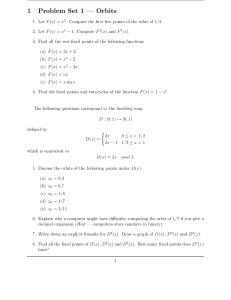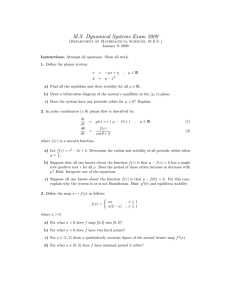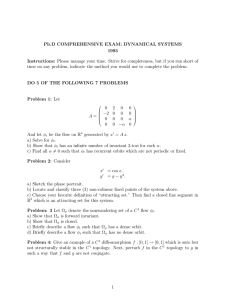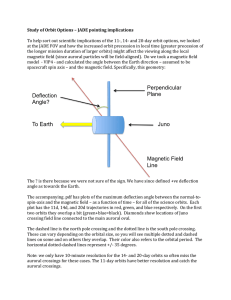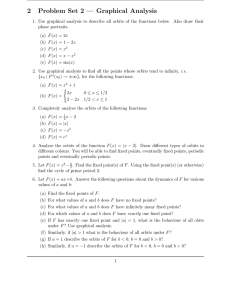MIT. Tricky Asymptotics Fixed Point Notes. 18.385j/2.036j ,
advertisement
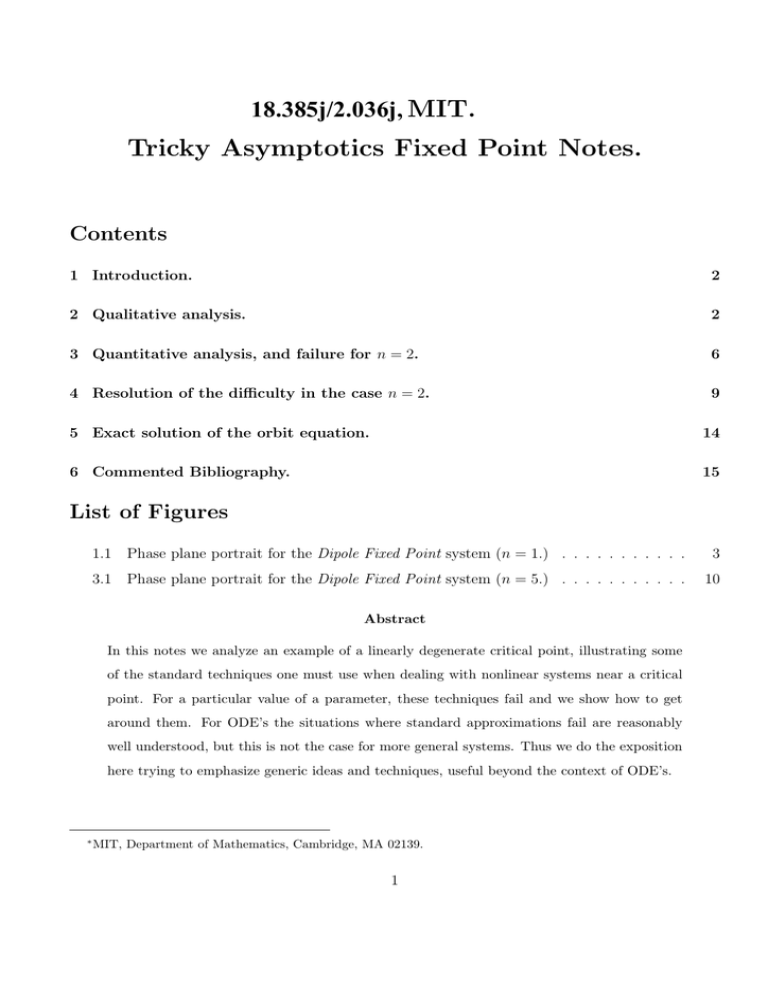
18.385j/2.036j, MIT. Tricky Asymptotics Fixed Point Notes. Contents 1 Introduction. 2 2 Qualitative analysis. 2 3 Quantitative analysis, and failure for n = 2. 6 4 Resolution of the difficulty in the case n = 2. 9 5 Exact solution of the orbit equation. 14 6 Commented Bibliography. 15 List of Figures 1.1 Phase plane portrait for the Dipole Fixed Point system (n = 1.) . . . . . . . . . . . 3 3.1 Phase plane portrait for the Dipole Fixed Point system (n = 5.) . . . . . . . . . . . 10 Abstract In this notes we analyze an example of a linearly degenerate critical point, illustrating some of the standard techniques one must use when dealing with nonlinear systems near a critical point. For a particular value of a parameter, these techniques fail and we show how to get around them. For ODE’s the situations where standard approximations fail are reasonably well understood, but this is not the case for more general systems. Thus we do the exposition here trying to emphasize generic ideas and techniques, useful beyond the context of ODE’s. ∗ MIT, Department of Mathematics, Cambridge, MA 02139. 1 Tricky asymptotics fixed point. 1 Notes: 18.385j/2.036j ,MIT. Fall 2004 . 2 Introduction. Here we consider some subtle issues that arise while analyzing the behavior of the orbits near the (single, thus isolated) critical point at the origin of the Dipole Fixed Point system (see problem 6.1.9 in Strogatz book) dx 2 = xy , dt n and dy = y 2 − x2 , dt (1.1) where 0 < n ≤ 2 is a constant. Our objective is to illustrate how one can analyze the behavior of the orbits near this linearly degenerate critical point and arrive at a qualitatively1 correct description of the phase portrait. We will use for this “standard” asymptotic analysis techniques. The case n = 2 is of particular interest, because then the standard techniques fail, and some extra tricks are needed to make things work. Just so we know what we are dealing with, a computer made phase portrait for the system2 (case n = 1) is shown in figure 1.1. Other values of 0 < n ≤ 2 give qualitatively similar pictures. However, for n > 2 there is a qualitative change in the picture. We will not deal with the case n > 2 here, but the analysis will show how it is that things change then. The threshold between the two behaviors is precisely the tricky case where “standard” asymptotic analysis techniques do not work. 2 Qualitative analysis. We begin by searching for invariant curves, symmetries, nullclines, and general “orbit shape” prop­ erties for the system in (1.1). A. Symmetries. The equations in (1.1) are invariant under the transformations:3 A1. x −→ −x A1 and A2 show that we need only study the behav­ A2. y −→ −y and t −→ −t ior of the equation in the quadrant x ≥ 0, y ≥ 0. A3. x −→ ax, y −→ at, and t −→ t/a, for any constant a > 0. 1 With quantitative extra information. 2 The analysis will, however, proceed in a form that is independent of the information shown in this picture. Notice that these types of invariances occur as a rule when analyzing the “leading order” behavior near degenerate 3 critical points; because such systems tend to have homogeneous simple structures. Notes: 18.385j/2.036j , MIT. Tricky asymptotics fixed point. Fall 2004 . 3 Dipole Fixed Point: xt = 2xy/n, yt = y2 - x 2, n = 1. 2 1 y 0 -1 -2 -2 -1 0 1 2 x Figure 1.1: Phase plane portrait for the Dipole Fixed Point system (1.1) for n = 1. The qualitative details of the portrait do not change in the range 0 < n ≤ 2. However, for n > 2 differences arise. The last set of symmetries (A3) shows that we need only compute a few orbits, since once we have one orbit, we can get others by expanding/contracting it by arbitrary factors a > 0. Note that we say “a few” here, not “one”! This is because the expansion/contractions of a single orbit need not fill up the whole phase space, but just some fraction of it. A particularly extreme example of this can be seen in figure 1.1, where the orbit given by y > 0 and x ≡ 0 simply gives back itself upon expansion. On the other hand, we will show that any of the orbits on x > 0 (or x < 0) gives all the orbits on x > 0 (respectively, x < 0) upon expansion/contraction.4 Actually: this is, precisely, the property that is lost for n > 2! Note: (A2) shows that this system is reversible. On the other hand, because there are open 4 It even gives the special orbits on the y­axis by taking a = ∞, and the critical point by taking a = 0. Tricky asymptotics fixed point. Notes: 18.385j/2.036j , MIT. Fall 2004 . 4 sets of orbits that are attracted by the critical point (we will show this later), the system is not conservative. In fact, this is an example of a reversible, non­conservative system with a minimum number of critical points. B. Simple invariant curves. The y­axis (x ≡ 0) is an invariant line. Along it the flow is in the direction of increasing y, with vanishing derivative at the origin only. This invariant line is clearly seen in figure 1.1. √ n For n > 2, two further (simple) invariant lines are: y = ± √ x. n−2 Whenever a one parameter family of symmetries exist (such as (A3)), you should look for invariant curves that are invariant under the whole family. In this case, this means looking for straight lines (which is what we just did.) C. Nullclines. The nullclines are given by C1. The x­axis (y ≡ 0), where ẋ = 0 (and, for x = � 0, ẏ < 0.) � 0, ẏ > 0.) C2. The y­axis (x ≡ 0), where ẋ = 0 (and, for y = C3. The lines y = ±x, where ẏ = 0. In the first quadrant we also have ẋ > 0 here. D. Orbit shape properties. In the first quadrant (from (A) above, it is enough to study this x > 0 and y > 0 quadrant only), consider the equation for the orbits dy n(y 2 − x2 ) n = = dx 2xy 2 � y x − x y � . (2.1) A simple computation then shows that: � � � � d2 y n 1 x dy n y 1 = + 2 − + 2 2 dx 2 x y dx 2 x y �� � n � = − 2 3 (2 − n)y 2 + nx2 y 2 + x2 < 0 . 4x y (2.2) This shows that the orbits are (strictly) concave in this quadrant. Note, however, that the inequality breaks down for n > 2. Then the orbits are concave for (n − 2)y 2 < nx2 and convex for (n − 2)y 2 > nx2 . Tricky asymptotics fixed point. Notes: 18.385j/2.036j , MIT. Fall 2004. 5 All this information can now be put together, to obtain a first approximation to what the phase portrait must look like, as follows: I. Region 0 < y < x (y˙ < 0 and x˙ > 0.) The orbits enter this region (horizontally) across the nullcline y = x, bend down, and must eventually exit the region (vertically) across the nullcline y = 0. It should be clear that, once we show that one orbit exhibiting this behav­ ior occurs, then all the others will be expansion/contractions of this one and, in particular, of each other (see (A3).) The only point that must be clarified here is why we say above that the orbit “must eventually exit the region”? Why are we excluding the possibility that y will decrease, and x will increase, but in such a fashion that the orbit diverges to infinity, without ever making it to the x­axis? The answer to this is very simple: this would require the orbit to have an inflection point, which it cannot have.5 II. Region 0 < x < y (y˙ > 0 and x˙ > 0.) Considering the flow backwards in time, we see that all the orbits that exit this region (horizontally, entering region I) across the nullcline y = x, must originate at the critical point. However: do all the orbits that originate at the critical point, exit this region across the nullcline y = x? Or is it possible for such an orbit to reach infinity without ever leaving this region? — in fact, this is precisely what happens when n > 2, when all the orbits in the region √ √ n − 2 y > n x do this. Figure 1.1 seems to indicate that this is not the case, but: how can be sure that a very thin pencil of orbits hugging the y­axis does not exist? In section 3 we will show that all the orbits leave the critical point with infinite slope (i.e.: vertically). Consider now any orbit that exits this region through the nullcline y = x, and (we know) starts vertically at the critical point. We also know that all the ex­ pansions/contractions of this orbit must also be orbits (see (A)), and it should be clear that these will fill up this region completely (the fact that the orbit starts vertically is crucial for this.) But then there is no space left for the alternative type of orbits suggested in the prior paragraph, thus there are none. This clarifies the point in the prior paragraph. 5 See (D) — notice that the orbits are always concave in this region, for all values of n > 0. Tricky asymptotics fixed point. Notes: 18.385j/2.036j , MIT. Fall 2004. 6 III. Conclusion. With this information, and using the symmetries in (A), we can draw a qualitatively correct phase plane portrait, which will look as the one shown in figure 1.1. It should be clear from this figure that: The index of the critical point is I = 2. 3 Quantitative analysis, and failure for n = 2. Our aim in this section is to get some quantitative information about the orbits near the critical point. In particular, exactly how they approach or leave it. Our approach below is “semi­rigorous”, in the sense that we try to justify all the steps as best as possible, without going to “extremes” (whatever this means). 100% mathematical rigor in calculations like the ones that follow is possible in simple examples like the one we are doing — and not even very hard — but quickly becomes prohibitive as the complexity of the problems increases. But the type of techniques and way of thinking that we follow below remain useful well beyond the point where full mathematical rigor is currently achievable. Thus, provided one is willing to pay the price of not having the “absolute” certainty that full mathematical rigor gives, large gains can be made — while maintaining a “reasonable” level of certainty. This point of view is pretty close to the one adopted by Strogatz in his book. We begin by showing the result announced (and used) towards the end of section 2, namely: that all the orbits leave/approach the critical point vertically. As before, we restrict out attention to the first quadrant, and assume x, y > 0. a. All the orbits must have a tangent limit direction as they approach the origin. This follows dy easily from the concavity of the orbits (see (D)): as t → −∞, the slope increases mono­ dx tonically. Thus, it must have a well defined limit (which may be ∞; in fact, the aim here is to show that this limit is ∞.) b. Suppose that there is an orbit that does not approach the critical point vertically. Then, the result in item (a) shows that we should be able to write y ≈ αx , for 0 < x � x , (3.1) Tricky asymptotics fixed point. Notes: 18.385j/2.036j , MIT. where 1 ≤ α < ∞ is a constant,6 in fact α = lim x→0 Fall 2004. 7 dy . Substitution of this into equation (2.1) dx then yields (upon taking the limit x → 0) � α= n 1 α− 2 α � ⇐⇒ (n − 2)α2 = n , (3.2) which has no solution for 0 < n ≤ 2! It follows that an orbit approaching the critical point at a finite slope cannot occur — which is precisely what we wanted to show. We now become more ambitious and ask the question: How exactly do the orbits leave the critical point? — that is to say: What is the leading order behavior in their shape for 0 < x << 1? As we will show later (see remark 3.2), the answer to this question is useful in calculating the rate (in time) at which the solutions approach the critical point. To answer this last question we proceed as follows: We know that the orbits have infinite slope near the critical point, thus we can write y � x for 0 < x � 1 . (3.3) Using this, we should be able to replace equation (2.1) by the approximation dy n y2 ny ≈ = . dx 2xy 2x (3.4) y ≈ βxn/2 , (3.5) This yields where β is a constant. This last step is not rigorous, by a long shot, and we must be a bit careful before accepting it. Equation (3.4) is correct (the neglected terms are smaller than the ones kept), but it is not clear that (upon integration) the neglected terms will not end up having a significant contribution to the solution of the equation. Thus before we accept equation (3.5) we must make some basic checks (these sort of checks are important, you must always try to do as much as it is reasonable and you can do along these lines), such as: 6 We know that α ≥ 1 because the orbit must leave the critical point staying above the line y = x. Tricky asymptotics fixed point. c. Consistency Notes: 18.385j/2.036j , MIT. Fall 2004. 8 with known facts. For example: c1. For 0 < n < 2, (3.5) is consistent with (3.3). c2. For n > 2, (3.5) is not consistent with (3.3). However, our proof that the orbits approach the critical point vertically (which is what (3.3) is based on) does not apply for n > 2. In fact, for n > 2, (3.2) provides a very definite (neither infinite nor zero) direction of approach — which happens to agree with the invariant lines mentioned in (B) earlier. So, there is no contradiction (see remark 3.1 below for a brief description of what the situation is when n > 2.) c3. For n = 2, (3.5) is not consistent with (3.3). Since our proof that the orbits approach the critical point vertically (which implies (3.3)) does apply for n = 2, we have a problem here, a rather tricky one, which we will address in section 4 below. d. Self­consistency (plug in the proposed approximation into the full equation and check that the neglected terms are indeed small). In this case the neglected term in the equation is nx , which has size (using (3.5)) 2y nx = O(x(2−n)/2 ) , 2y while dy ny = = O(x(n−2)/2 ) . dx 2x For the retained terms to be smaller than the neglected terms, we need (2 − n)/2 > (n − 2)/2, which is true only for n < 2. Thus (3.5) is self­consistent only for n < 2. e. Estimate the error. That is, write the solution as y = βxn/2 + y1 , and assume y1 � βxn/2 . Then use this to get an approximate equation for y1 , solve it, and check that, indeed: y1 � βxn/2 . In the case 0 < n < 2 (the only one worth doing this for, since the other cases have already failed the two prior tests) one can do not only this, but repeat the process over and over again, obtaining at each stage higher order asymptotic approximations to the solution. That is, an asymptotic series of the form y = βxn/2 + y1 + y2 + y3 + . . . , where yn+1 � yn , can be systematically computed. (3.6) Tricky asymptotics fixed point. Remark 3.1 Notes: 18.385j/2.036j , MIT. Fall 2004. 9 What happens when n > 2. The same methods that work for 0 < n < 2 can be used to study this case (but a bit more work is needed). The main difference in the phase portrait occurs because all the orbits (except for the √ √ special ones along the y­axis) approach the critical point along the lines n − 2 y = ± n x. √ √ For n − 2 |y | < ± n |x|, the orbits look rather similar to the orbits in the case 0 < n < 2, that is to say: closed loops starting and ending at the critical point, except that they approach the critical √ √ point along the lines n − 2 y = ± n x, not the y­axis. √ √ For n − 2 |y | > ± n |x|, the orbits approach the critical point at one end (along the lines √ √ n − 2 y = ± n x) and infinity at the other (ending parallel to the y­axis there). In between their slopes vary steadily (no inflection points) from one limit to the other. Figure 3.1 shows a typical phase plane portrait for the n > 2 case. From the figure it should be clear that we still Remark 3.2 have for the index: I = 2. Rate of approach to the critical point (0 < n < 2.) Substituting (3.5) into (1.1), we obtain (near the critical point, where both x and y are small) dx 2β (n+2)/2 ≈ x , dt n dy ≈ y2 , dt and where (in the second equation) we simply used the fact that y � x. Thus � 1 x=O (−t)2/n 4 � � � and y=O 1 t , as t → −∞ . Resolution of the difficulty in the case n = 2. Again we restrict out attention to the first quadrant, and assume x, y > 0. The results of section 3 are quite contradictory, when it comes to the case when n = 2. On the one hand, we showed that (3.3) must apply. But, on the other hand, when we implemented the consequences of this result (in (3.4)) we arrived at the contradictory result in (3.5). As we pointed out, the step from (3.4) to (3.5), is not foolproof and need not work. On the other hand, it usually does, and when it does not, things can get very subtle.7 We will show next a simple approach that works in fixing some problems like the one we have. 7 In fact, there are some open research problems that have to do with failures of this type, albeit in contexts quite a bit more complicated than this one. Tricky asymptotics fixed point. Notes: 18.385j/2.036j , MIT . Fall 2004. 10 Dipole Fixed Point: xt = 2xy/n, yt = y2 - x 2, n = 5. 2 1 y 0 -1 -2 -2 -1 0 1 2 x Figure 3.1: Phase plane portrait for the Dipole Fixed Point system (1.1) for n = 5. The qualitative details of the portrait do not change in the range 2 < n, but differ from those that apply in the range 0 < n < 2 (see figure 1.1.) What happens for n = 2 must be, in same sense, a limit of the behavior for n < 2, as n → 2. Now, look at (3.5) in this limit: it is clear that the behavior must become closer and closer to that of a straight line (since the exponent approaches 1), at least locally (i.e.: near any fixed value of x). On the other hand, it would be incorrect to assume that this implies that the orbits become straight in this limit, because this ignores that fact that β will depend on n too. In fact, we know that the limit behavior is not a straight line, but this argument shows that is must be very, very close to one. Thus we propose to seek solutions of the form y = αx , (4.1) Tricky asymptotics fixed point. Notes: 18.385j/2.036j , MIT . Fall 2004 . 11 where α = α(x) is not a constant, but behaves very much like one as x → 0. By this we mean that, when we calculate the derivative dy dα =α+ x, dx dx (4.2) dα x, dx (4.3) we can neglect the second term. That is α� as x → 0 . We also expect that α → ∞ as x → 0, since we know that the orbits must approach the critical point vertically. Notice that this proposal provides a very clean explanation of how it is that the step from (3.3) to (3.5), via (3.4), fails (and provides a way out): In writing (3.4) some small terms are neglected, and what is left is (when writing the solution in the form (4.1)) is α. Comparing this with (4.2), we see that the neglected terms are, precisely, those that make α non­constant. Thus, by neglecting them we end predicting that α is a constant,8 which leads to all the contradictions pointed out in section 3. What we need to do, therefore, is calculate the leading order correction9 to the right hand side dα in (3.4), and equate it to the second term in (4.2). This will then give an equation for , which dx we must then solve. If the solution is then consistent with the assumption above in (4.3), we will have our answer and the mystery will be solved.10 We now implement the process described in the prior paragraph. The leading order correction to the right hand side in (3.4) is (recall n = 2 now) correction = − x 1 =− , y α (4.4) which is small, since α is large for 0 < x � 1. Thus the equation for α is: x dα 1 =− dx α � =⇒ α= c − 2 ln(x) , (4.5) where c is a constant. It is easy to see that this is consistent with (4.3). 8 That is, α = β in (3.5). 9 That is to say: plug (4.1) into equation (2.1) and then expand, using the fact that α is large. Note that this answer must be subject to the same type of basic checks we went through in (c), (d), and (e) of 10 section 3, before we accepted (3.5) in the case 0 < n < 2. Tricky asymptotics fixed point. Notes: 18.385j/2.036j , MIT. Fall 2004. 12 Remark 4.1 It turns out that this problem is so simple that the “leading order” correction — i.e.: � � −1 above in (4.4) — is everything! Thus (4.1 – 4.5) in fact provides not just an approximation α near the critical point, but an exact solution! It follows that we do not need to check for any “consistencies” to make sure that the “approximation” can be trusted (in the manner of (c), (d), and (e) of section 3.) Of course, in more complicated problems this will (generally) not happen, and expressions like the one in (4.1) — with α given by (4.5) — will end up being just the first term in an asymptotic approximation for the orbit shape. At this point you may wonder: what exactly is the “method” proposed here? Well, as usual with these kind of things, there is no precise recipe that can be given — just as there is no precise recipe that can be given to explain the “standard” methods. However, just as in the standard methods one can give a vague — and rather short — list of things to do (e.g.: balance terms and look for pairs that may dominate, therefore simplifying the problem11 ) we provide below a list of hints as to what one can do when faced with problems like the one we treat in this section. In the end, though, each problem is its own thing and (at least with our present level of understanding) the only way to learn how to do these things “well” is by painfully acquired experience. When faced with a problem of this type, you may try this: 1. See if you can add a parameter to the equations (say: n), in such a way that the difficult � nc . problem corresponds to some critical value n = nc , and you can do the problem for n = In the example here nc = 2. 2. Look at the behavior of the solution for the “easier” problems as n → nc . This limit will, almost certainly, be singular. What you should then do is try to extract a functional form (by looking at these limits) with appropriate properties.12 The aim is to “guess” what the “right” form to try for the solution is, by looking at the behavior of the solutions of the nearby problems on each side of nc (these ought to “sandwich” the right behavior between them.) 11 Books in asymptotic expansions deal with these and other ideas at length; see (for example) Bender, C. M., and Orszag, S. A. (1978) Advanced Mathematical Methods for Scientists and Engineers (McGraw­Hill, New York.) 12 Sorry if this sounds very vague; it is very vague, but it is the best I can do! Tricky asymptotics fixed point. Notes: 18.385j/2.036j , MIT. Fall 2004 . 13 In the example studied here we had (β is a constant): y ≈ β x1−� , √ 1−� y≈ √ x, � where � = nc − n , 2 when n < nc = 2 and where � = n − nc , 2 when n > nc = 2 . In the first case the limit behavior is βx, but it is a very non­uniform limit near x = 0 (see what happens with the derivatives.) In the second case there is not even a limit. The solutions for both cases, however, have the common form αx, where the bad behavior is restricted to α. Thus we picked this common form, and assumed properties for α “intermedi­ ate” between the behaviors on each side: a constant, but not quite one, and going to infinity as x → 0. 3. Alternatively, look at the solution13 that fails for n = nc . This solution will satisfy an ap­ proximate form of the equations (where some small terms have been neglected), but will be inconsistent with the assumptions made in arriving to it — e.g.: the small terms end up not being as small as assumed. The failure must occur because the neglected small terms have some important effect. Therefore, try the following: assume a form of the solution equal to the one that fails, but allow any free parameters in this solution to be “slow” functions, rather than constants (this means: when taking derivatives, the terms involving derivatives of the parameters will be higher order.14 ) Then use this “slow” dependence to eliminate the leading order terms in the errors to the approximations that lead to the failed solution in the first place. If you are lucky, and clever enough, this might fix the problem. In the example studied here, the failure occurs for n = 2, when equation (3.4) becomes dy y = , dx x with solution y = αx (α a constant.) This solution is inconsistent with the assumption y � x used in deriving (3.4). Thus we took this form, but made the free constant parameter in the solution (α) a slow function of x, with 13 14 Given by “standard” techniques. These functions should also have properties (e.g.: large, small, ... in some limit) that make the assumed form consistent with the approximations that lead to the equations they solve. Tricky asymptotics fixed point. Notes: 18.385j/2.036j , MIT. Fall 2004 . 14 the additional property α � 1 as x → 0 (so that y � x still applies.) This then works, in this case so well that it gives an exact solution. The three hints outlined above will work straightforwardly for relatively simple problems, both in ODE’s and PDE’s. Beyond that . . . 5 Exact solution of the orbit equation. Equation (2.1) is simple enough that one can solve it exactly (for all values of n.) We can then use this exact solution to verify that everything done earlier (using approximate arguments) is absolutely correct. This is not a luxury one can afford too often; generally exact solutions are not available and rigorous arguments are either too expensive or impossible — thus, the only tools one is left with are numerical computations, approximate analysis, and experimental observations.15 Let us now solve (2.1). Multiply both sides of the equation by 2y and integrate. This yields a linear equation in y 2 , namely: dy 2 n 2 − y = −nx . dx x Now multiply the equation by x−n , and integrate again, to obtain (assume x > 0): dy 2 x−n = −nx1−n . dx From this the following solutions follow: • Case 0 < n < 2. y 2 = 2Rxn − n x2 , 2−n � for 0 ≤ x ≤ 1 2R(2 − n) 2 − n , n � (5.1) where R > 0 is a constant. For n = 1 these are circles of radius R, centered at (x, y) = (R, 0). • Case n = 2. y 2 = (2 ln(x0 ) − 2 ln(x)) x2 , for 0 ≤ x ≤ x0 , (5.2) where x0 > 0 is a constant. 15 For 2­D problems all sorts of theoretician luxuries are available. But real problems are seldom this simple. Tricky asymptotics fixed point. • Notes: 18.385j/2.036j , MIT. Fall 2004 . 15 Case n > 2. � n 2 y 2 = −Cxn + x , n−2 for 0 ≤ x ≤ 1 � n n−2 , (n − 2)C (5.3) where C > 0 is a constant (these are the orbits giving closed loops in figure 3.1), or y 2 = Cxn + n x2 , n−2 for 0 ≤ x , (5.4) where C ≥ 0 is a constant (these are the orbits that diverge to infinity in the sectors around the y­axis in figure 3.1.) 6 Commented Bibliography. Below I list a few books that I think might be of use to you. 1. Cole, J. D. (1968). Perturbation Methods in Applied Mathematics, Blaisdell, Waltham, Mass. Very nice and concise book (unfortunately, out of print.) It introduces the fundamental concepts in asymptotic methods, using examples from applications (fluid dynamics, mostly.) It aims at realistic scientific problems, so it deals mostly with PDE’s (not ODE’s). 2. Bender, C. M., and Orszag, S. A. (1978). Advanced Mathematical Methods for Scientists and Engineers, McGraw­Hill, New York. This book has an extensive treatment of many of the ideas in asymptotic (and other) methods, with many comparisons between the asymptotic approximations and numerical solutions. It introduces the methods using simple examples, so it deals (mostly) with ODE’s. 3. Coddington, E. A., and Levinson, N. (1955). Theory of Ordinary Differential Equations, McGraw­Hill, New York. A rigorous treatment of the theory of ODE’s, and a classic for this. This book proves ev­ erything, but it does so with minimum use of jargon. It has several chapters dedicated to asymptotic properties of ODE’s, a complete treatment of the Poincaré Bendixson theorem, and many other things. If you want hard core proofs, without excuses or unnecessary jargon, this is the place to go. Of course, it is a bit old, and a lot of the new theory is not here — Tricky asymptotics fixed point. Notes: 18.385j/2.036j , MIT. Fall 2004. 16 but you cannot really appreciate (or understand) any proof in the newer theory without this background. 4. Ince, E. L. (1926). Ordinary Differential Equations, Longmans, Green, London. There is also a Dover edition! Old, perhaps, but very good. A hard core exposition of the classical theory of ODE’s. THE END.
